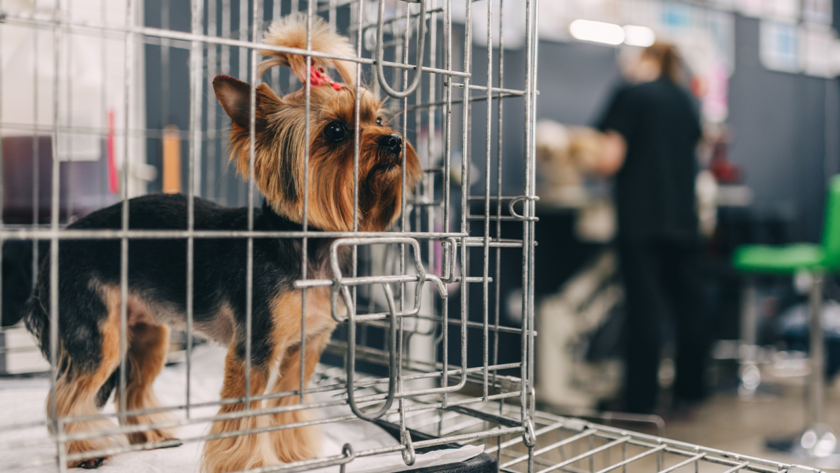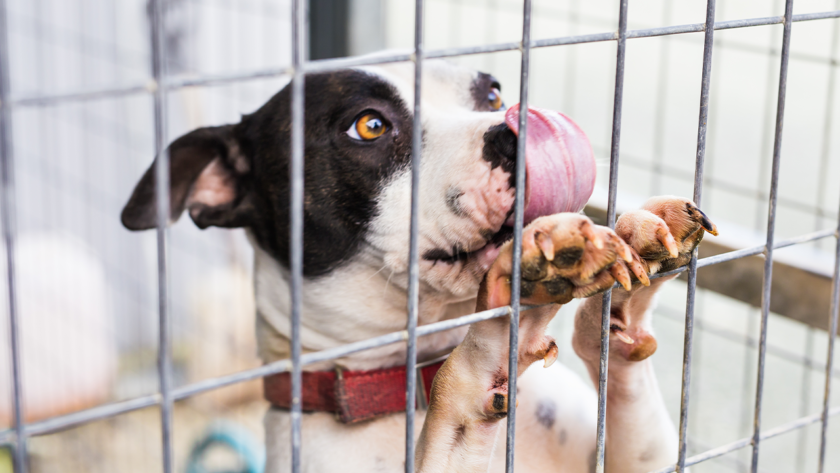Is it okay to leave a dog in crate 20 hours a day?
Many pet owners and animal care professionals are concerned about whether it is safe to confine a dog in crate 20 hours a day. This introduction aims to shed light on the implications of dog in crate 20 hours a day use, examining its impact on a dog’s physical safety and emotional well-being. Through an informative exploration of expert insights, animal behavior studies, and veterinary advice, we seek to provide a comprehensive overview that helps pet owners make informed decisions about using dog crates responsibly and ensuring the health and happiness of their furry companions.
How Long Can Dogs Stay In a Crate?
At a minimum, dogs should be allowed out of their crates every 4-6 hours to ensure they can relieve themselves, stretch, and engage in some form of physical activity. This guideline is critical for maintaining good physical health and supporting their emotional and mental well-being. Extended periods of confinement without adequate breaks can lead to a range of adverse outcomes, including anxiety, depression, and even physical issues such as muscle atrophy. Therefore, pet owners need to integrate regular breaks from the crate into their dog’s daily routine, facilitating a balance between security, safety, and freedom.

How Long Can Puppies Stay in a Crate?
For puppies, the recommended crate time is even shorter. According to the American Society for the Prevention of Cruelty to Animals (ASPCA), puppies should not be confined in a crate for more than three hours. Puppies have smaller bladders and higher energy levels so they can not stay , requiring more frequent potty breaks and playtime.
Furthermore, ensuring that the crate is appropriately sized for a puppy is essential. A crate that is too big can lead to accidents, as puppies may designate one area for sleeping and another for eliminating waste. To prevent this, pet owners should gradually increase the size of the crate as their puppy grows.
Puppy Age Appropriate time in the crate
0-8 weeks It’s best not to leave puppies this young alone in a crate. If you have to, let it be for an hour at most. Breeders typically place puppies below 8 weeks in a pen as it has more room.
10 to 12 weeks 2 ½ to 3 ½ hours
12 to 16 weeks 3 – 4 hours
Above 6 months to 12 months 4– 5 hours

Common Mistakes to Avoid When Crating Your Dog.
- Not providing enough ventilation
- Using the crate as punishment
- Keeping the crate in an isolated location
- Forgetting to remove the dog’s collar before crating
- Neglecting to provide water for the dog inside the crate
You can also check “Why Is My dog whining in crate at night”
Not providing enough ventilation
Ensuring proper ventilation within a dog’s crate is crucial for maintaining a healthy and comfortable environment. A lack of airflow can lead to overheating and difficulty breathing, especially in warmer climates or during the summer months. To prevent these issues, choose a crate with sufficient ventilation on all sides and avoid covering it with thick blankets or placing it in direct sunlight.
Using the crate as punishment
Using a crate as a form of punishment can lead to negative associations for your dog, transforming what should be a safe and cozy retreat into a space of fear and anxiety. This mistake can undermine the crate’s effectiveness as a training tool and damage the trust between you and your pet. Instead, the crate should always represent a positive, secure space.
Keeping the crate in an isolated location
Placing a dog’s crate in an isolated area of the home can exacerbate feelings of loneliness and anxiety, particularly for social animals that thrive on interaction and attention. To foster a sense of inclusion and comfort, position the crate in a room where the family spends a significant amount of time, such as the living room, ensuring the dog feels part of the household activities even when crated.
Forgetting to remove the dog’s collar before crating
Leaving a collar on a dog while they are in the crate poses a risk of entanglement, potentially leading to injury or even strangulation. Always remove your dog’s collar before placing them in the crate to ensure their safety and prevent any accidents.
Neglecting to provide water for the dog inside the crate
Hydration is vital for dogs, and failing to provide water inside the crate, especially for extended periods, can lead to dehydration. To avoid this, consider attaching a water dispenser to the crate that allows your dog to drink as needed without spilling.
Ensuring Your Dog’s Comfort in a Crate
Beyond providing regular breaks and avoiding common mistakes, pet owners can take additional steps to ensure their dog’s comfort while crated. These include:
- Providing soft bedding or a comfortable mat inside the crate
- Engaging in positive reinforcement by offering treats or toys when crate time is over
- Gradually increasing crate time to help the dog acclimate and feel more at ease
- Placing a familiar and comforting item, such as a blanket or toy, in the crate with the dog
you can also check "10 Fun and Interactive Crate Games for Dogs"
By taking these measures, pet owners can help their dogs feel safe, secure, and content while crated and prevent any potential negative associations. It’s crucial to remember that crates should not be used as a long-term solution for confinement but rather as a temporary tool for training and safety. With responsible usage and proper care, crates can become a valuable resource for both dogs and their owners. Overall, the key to ensuring a positive experience for your dog in a crate is to approach it with patience, understanding, and compassion.
By following these guidelines and making necessary adjustments based on your dog’s individual needs, you can help them understand that the crate is a safe, comfortable, and essential part of their daily routine. With proper care and training, your dog can learn to view their crate as a positive and secure space that provides both physical and emotional benefits.

Pros and Cons for Caging Your Dog
Pros of Caging Your Dog
- Creates a Safe Haven: A crate can serve as a secure and comforting space for your dog, where they can retreat to rest or when they feel overwhelmed.
- Aids in House Training: Crates help in establishing a routine for puppies, teaching them to hold their bladder and bowel movements, which facilitates quicker house training.
- Prevents Destructive Behavior: When supervised properly, crating can prevent your dog from developing habits of chewing on furniture or getting into dangerous household items.
- Travel Safety: Crates provide a safe and familiar environment for dogs during car travels, reducing their stress and protecting them in case of sudden stops.
- Ease of Integration into Busy Households: For homes with small children or other pets, a crate can help manage interactions and ensure the dog has a peaceful space.
- Simplifies Veterinary Visits: Dogs accustomed to crates usually find it less stressful to be in a kennel or undergo examinations at the vet.
- Facilitates Training and Management: Crates are useful tools in behavior modification training, helping to establish limits and manage anxiety.
- Emergency Preparedness: In cases of emergency, dogs that are crate-trained can be more quickly and safely evacuated or taken to safe locations.
- Promotes Healing Post-Surgery: Crating can limit a dog’s physical activity as required during recovery from surgery or injury.
- Provides Peace of Mind: Knowing your dog is secure in their crate can give owners peace of mind when leaving the house for a few hours.
Cons of Caging Your Dog
- Risk of Overuse: Relying too much on a crate for dog management can lead to excessive confinement, potentially impacting the dog’s physical and mental health.
- Association with Negative Experiences: If not introduced properly, dogs may associate the crate with isolation or punishment, leading to anxiety and fear.
- Barriers to Socialization: Excessive crating can prevent dogs from properly socializing, which is crucial for their development and behavior.
- Physical Restrictions: Long periods in a crate can restrict movement, leading to muscle atrophy or other physical issues in dogs.
- Behavioral Problems: Dogs that are crated too often may exhibit signs of depression, anxiety, or increased aggression.
- Isolation: Dogs are social animals, and prolonged periods in a crate can lead to feelings of isolation and loneliness.
- Training Dependency: Some dogs may become overly reliant on their crate, showing reluctance or anxiety when left outside of it.
- Inadequate Exercise: Crates limit the physical activities a dog can engage in, possibly leading to insufficient exercise if not properly managed.
- Health Issues: Extended time in a crate without proper hygiene can lead to health concerns, including urinary tract infections or issues related to inadequate access to water.
- Cost: Quality crates can be expensive, and as dogs grow, larger sizes may be required, adding to the overall expense.
Conclusion
In conclusion, while crating your dog may have pros and cons, it is essential to approach it carefully and responsibly. Crates can be valuable tools for training, safety, and managing daily routines but should not be used as a long-term solution for confinement. With proper care, attention, and understanding of your dog’s needs, you can help them view the crate as a positive and secure space. Remember to always prioritize your dog’s well-being and consult with a professional if you have any concerns or questions about using crates. By following these guidelines, you can ensure a positive experience for both you and your furry companion.
FAQS
FAQS
How long a dog can stay in a crate safely?
A dog can safely stay in a crate for up to 8 hours for adult dogs but should be less for puppies due to their need for more frequent bathroom breaks. Always ensure they have access to water if crated for more than a few hours.
At what age can I start crate training my puppy?
You can start crate training a puppy as early as 8 weeks old. Begin with short periods of time and gradually increase as they become feel more comfortable within the crate.
Will crating my dog stop it from having accidents in the house?
Crating can help with house training since dogs naturally avoid soiling their sleeping areas. However, it should be paired with a consistent bathroom break schedule.
Can a crate be too big for a dog?
Yes, a crate too large for a dog may not provide the sense of security they need and might allow them to use one end as a bathroom. Ideally, a crate should be only large enough for the dog to stand, turn around, and lie down comfortably.
Is it wrong for a dog to crate at night?
No, crating a dog at night is not cruel if done correctly. It can provide them with a comfortable, secure place to sleep and help prevent wandering and possible accidents or destructive behavior.
How can I make my dogs feel more comfortable in crate?
Ensure the crate has a soft bed or blanket and safe chew toys. Placing the crate in a quiet but socially integrated area of your home can also help your dog feel more comfortable and less isolated.
What should I do if my dog dislikes its crate?
If your dog dislikes its crate, reintroduce it gradually with positive reinforcement. Use treats and toys to make crate time enjoyable, and never use the crate as punishment.
Can I crate my dog while at work?
Yes, you can crate your dog while at work, but ensure it’s not for extended periods like dog in crate 20 hours a day. Adult dogs can be crated up to 8 hours with access to water, but puppies need to be let out more frequently because a dog in crate 20 hours a day can not stay.
How do I know if I’m using the crate too much?
If your dog spends more time in the crate than out on a regular basis, exhibits signs of anxiety, depression, or aggression, or if you’re relying on the crate instead of proper training and socialization, it may indicate overuse.
What are the alternatives to using a crate for my dog?
Alternatives to crating include using baby gates to confine your dog to a puppy-proofed room, interactive toys to keep them occupied, hiring a dog walker for mid-day exercise, or enrolling them in doggy daycare for socialization and activity.



